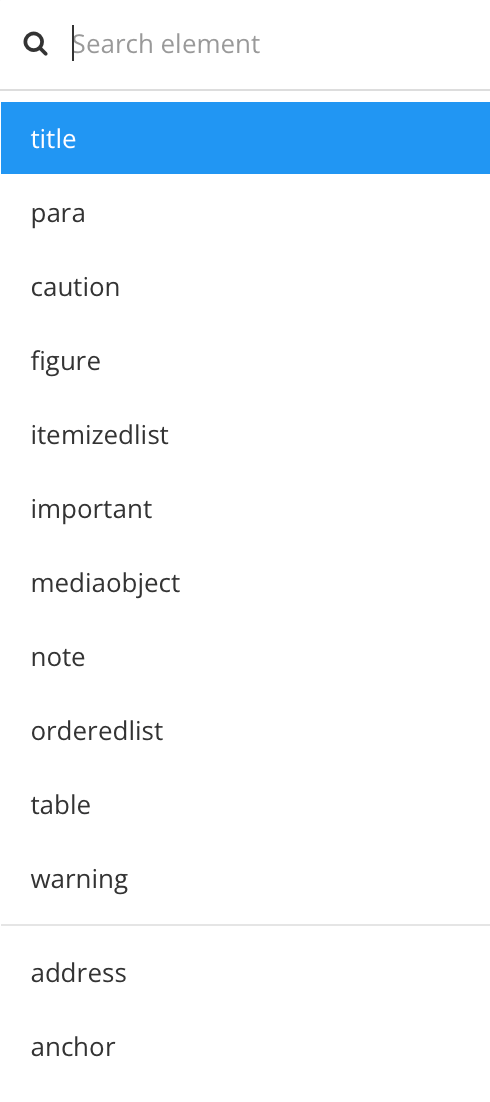Create an End-Of-Topic Bibliography
To create a bibliography that appears at the end of a topic:
In the Content Manager, select the topic that you want to edit.
Alternatively, you can create a new topic and edit that (see Create a Topic).
Position the cursor after the content in your topic. It needs to be on a new line, as if you were going to add a new paragraph.
Press Alt + Enter ⏎ (Windows) or Command ⌘ + Enter ⏎ (Mac) to display the Element Context Menu.

Add the bibliolist element.
Note
We recommend that you use
bibliolistinstead ofbibliographyfor end-of-topic bibliographies.Build your bibliography structure inside the
bibliolistelement. To build the structure, you will need to use the various bibliography elements, as described in the DocBook 5.2 documentation (see https://tdg.docbook.org/tdg/5.2/bibliography.html).We have included an example bibliography at the end of this article. It shows a valid bibliography structure, so you can copy that structure as a starting point.
Select Save.

In the content of your topic, add references (citations) from the content to the bibliography entries, see Add a Citation.
The following code shows the underlying structure of a valid end-of-topic bibliography. When you are creating your own bibliography, look at the example to see how the various bibliography elements are used. Some are "parents" and others are "children", for example, author is a parent of personname and personname is a parent of firstname.
<?xml version="1.0"?>
<section>
<title>Security in websites and data-centric applications</title>
<para>As websites and other data-centric applications become increasingly common, users are required to trust the confidentiality and integrity of the data the applications collect, store and present <citation>Harauz, Kaufman & Potter, 2009</citation>.</para>
<para>Because of this, these types of applications have become enticing targets for hackers wanting to input or access information without the owner’s permission. Inadequate security on the data input can allow hackers to create scams or spam, misleading or harassing users using automated bots <citation>Yan & El Ahmad, 2009</citation>.</para>
<para>These bots are capable of performing actions at a significantly higher rate than any human could. Bot creators have used this advantage to rig online polls, create large amounts of email addresses used for spamming and to attempt dictionary attacks against password systems <citation>von Ahn et al., 2003</citation>.</para>
<para>Furthermore, insufficient security when it comes to storing or accessing data can allow hackers access to confidential and private information such as credit card information and personal security details.</para>
<bibliolist>
<biblioentry>
<title>Data Security in the World of Cloud Computing</title>
<abbrev>Harauz, Kaufman & Potter, 2009</abbrev>
<author>
<personname>Harauz J</personname>
</author>
<author>
<personname>Kaufman L.M</personname>
</author>
<author>
<personname>Potter B</personname>
</author>
<pubdate>2009</pubdate>
<citetitle>IEEE Security & Privacy. 7</citetitle>
</biblioentry>
<biblioentry>
<title>CAPTCHA security: A Case Study. IEEE Security & Privacy</title>
<abbrev>Yan & El Ahmad, 2009</abbrev>
<author>
<personname>Yan J</personname>
</author>
<author>
<personname>El Ahmad A.S</personname>
</author>
<pubdate>2009</pubdate>
<citetitle>IEEE Security & Privacy. 7</citetitle>
</biblioentry>
<biblioentry>
<title>CAPTCHA: Using Hard AI Problems for Security</title>
<abbrev>von Ahn et al., 2003</abbrev>
<author>
<personname>Von Ahn L</personname>
</author>
<author>
<personname>Blum M</personname>
</author>
<author>
<personname>Hopper, N.J</personname>
</author>
<author>
<personname>Langford J</personname>
</author>
<pubdate>2003</pubdate>
<citetitle>Lecture Notes in Computer Science. 2656</citetitle>
</biblioentry>
</bibliolist>
</section>